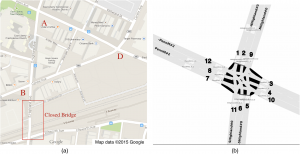The work on analyzing traffic impacts under arterial road closures using machine learning techniques on traffic flow data was published online on Journal of Transportation Engineering by American Society of Civil Engineers (ASCE).
- “An unsupervised learning approach for analyzing traffic impacts under arterial road closures: Case study of East Liberty in Pittsburgh,” Journal of Transportation Engineering, vol. 142, iss. 9, 2016.
![[DOI]](http://www.wiomax.com/wp-content/plugins/papercite/img/doi.png)
![[Bibtex]](http://www.wiomax.com/wp-content/plugins/papercite/img/bib.png)
@Article{Gu2016, Title = {An unsupervised learning approach for analyzing traffic impacts under arterial road closures: Case study of {East Liberty} in {Pittsburgh}}, Author = {Yiming Gu and Zhen Qian and Xiao-Feng Xie}, journal = {Journal of Transportation Engineering}, Year = {2016}, Number = {9}, Volume = {142}, Pages = {04016033}, Doi={10.1061/(ASCE)TE.1943-5436.0000860}, publisher={American Society of Civil Engineers} }

In this work, we adopt an unsupervised learning approach, k-means clustering, to analyze the arterial traffic flow data over a high-dimensional spatio-temporal feature space. As part of the adaptive traffic control system deployed around the East Liberty area in Pittsburgh, high-resolution traffic occupancy and count data are available at the lane level in virtually any time resolution. The k-means clustering method is used to analyze those data to understand the traffic patterns before and after the closure and reopening of an arterial bridge. The modeling framework also holds great potentials for predicting traffic flow and detect incidents. The main findings are that clustering on high-dimensional spatio-temporal features can effectively distinguish flow patterns before and after road closure and reopening and between weekends and weekdays. On arterial streets, clustering based on 5-min data is sufficient to eliminate potential distortion on measurements caused by signals. Either of the two, count or occupancy, is adequate to serve as a feature for effective pattern clustering. It is plausible to use data from only selected locations and time periods to infer representative flow patterns and detect arterial incidents, which allows applications in large-scale networks with cheap sensing. In addition, for some lanes, there exists a transitional time period (one week in this case study) immediately following the closure and reopening when traffic flow is transformed to a new type of daily pattern.
